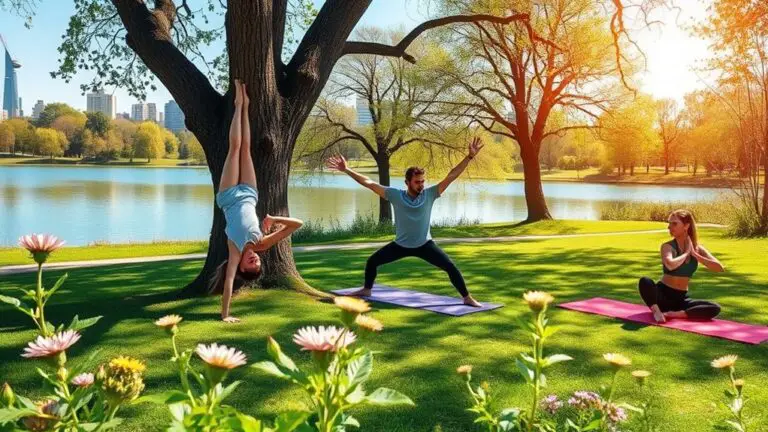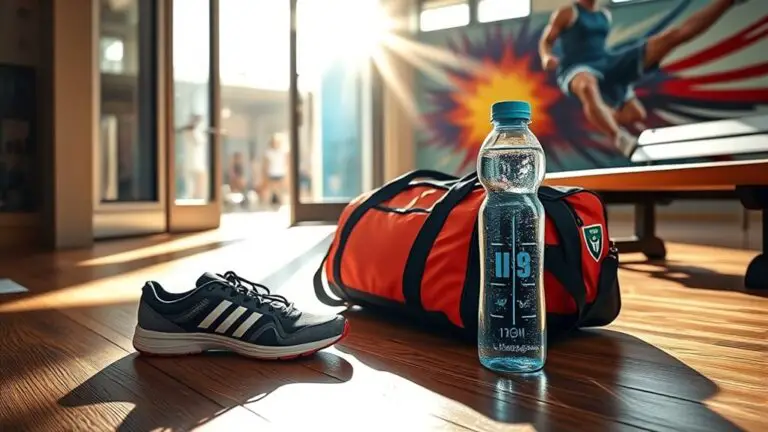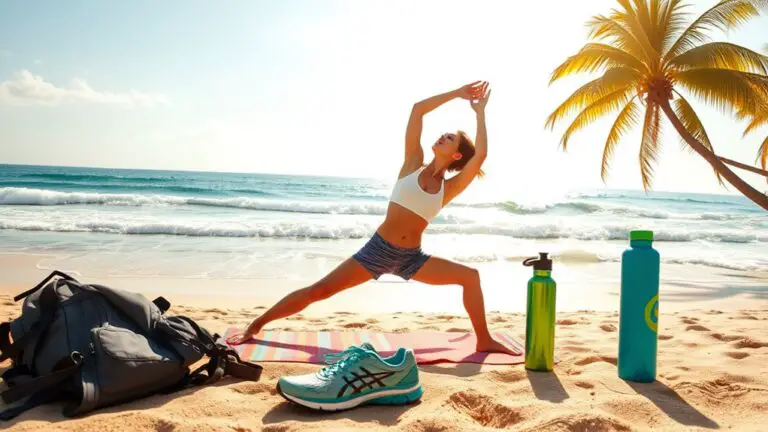How to Set up a Home Gym With Minimal Equipment
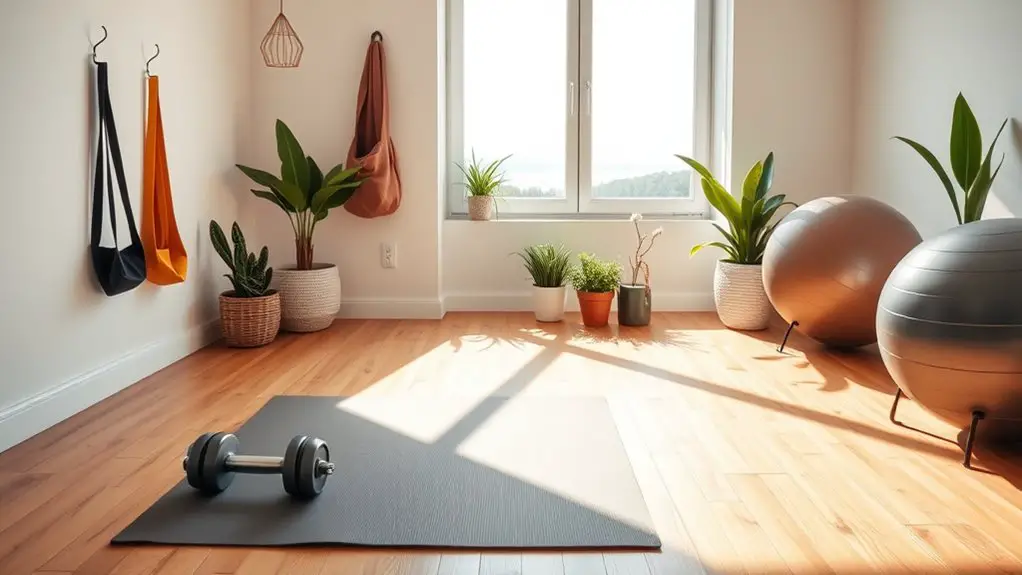
To set up a home gym with minimal equipment, start by measuring your space and budget. Prioritize essential items like a sturdy yoga mat, resistance bands, adjustable dumbbells, and a stability ball. Keep your workout area organized and clutter-free for safety. Incorporate bodyweight exercises, and consider creative options for cardio. Regularly maintain your equipment to guarantee longevity. By following these steps, you’ll create an effective workout space that meets your needs—there’s more to explore on optimizing your home gym setup.
Assessing Your Space and Budget
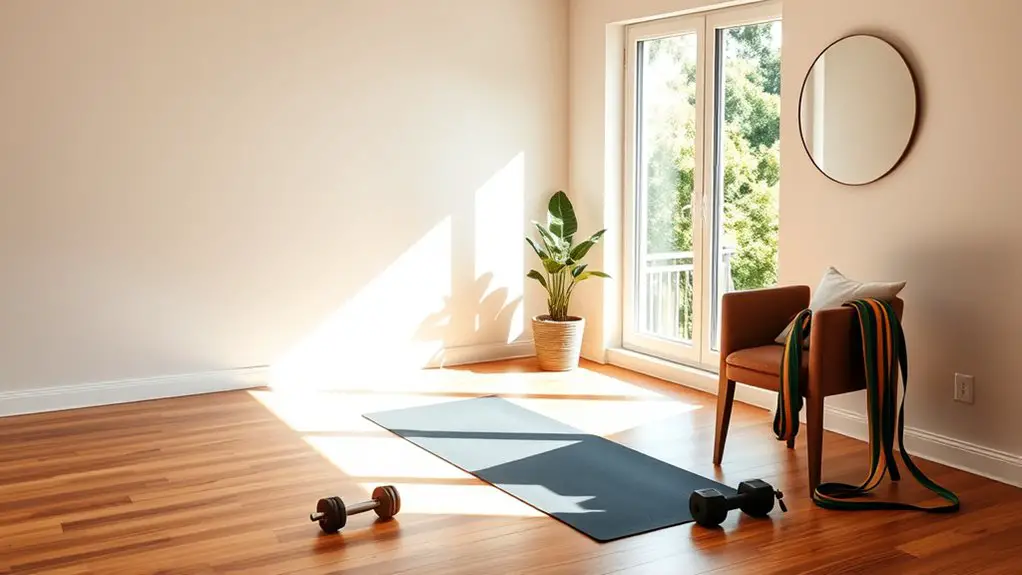
Before diving into the details of your home gym setup, it’s essential to assess your space and budget. Start by measuring your space dimensions—this’ll help you determine what equipment fits comfortably without crowding. It’s vital to leave room for movement, ensuring you can exercise safely without risk of injury.
Next, consider your budget constraints. You don’t need to break the bank to create an effective workout area. Prioritize the essentials and think about how much you’re willing to invest in both equipment and any necessary modifications to your space.
Essential Equipment for Your Home Gym
When setting up your home gym, choosing the right equipment is key to your success. You’ll want to focus on must-have basics, versatile multi-use gear, and budget-friendly options that fit your space. Let’s explore what essential items you really need to get started.
Must-Have Basics
Creating a home gym doesn’t have to be overwhelming; just a few essential pieces of equipment can make a world of difference. Start with a sturdy yoga mat for comfort and stability during floor exercises. Resistance bands are another must-have for their versatility and safety—perfect for strength training without heavy weights. A set of dumbbells can also be a great addition to your workout space, allowing for a range of exercises while keeping your joints safe. Finally, consider a stability ball to enhance core strength and balance. With these home gym essentials, you’ll have a solid foundation to build your fitness routine, all while prioritizing safety and efficiency in your workouts.
Versatile Multi-Use Equipment
To maximize your home gym’s potential, investing in versatile multi-use equipment is key. This equipment not only enhances your workout options but also guarantees you can perform various bodyweight exercises safely. Here are some essentials to take into account:
- Resistance Bands: Perfect for strength training and stretching, these bands add resistance without heavy weights.
- Adjustable Dumbbells: They save space and allow for different weight increments, ideal for various exercises.
- Stability Ball: Great for core workouts and can be used in place of a bench for added versatility.
- Pull-Up Bar: Useful for upper body strength, it can also aid in bodyweight exercises like chin-ups.
Budget-Friendly Options
Setting up a home gym on a budget doesn’t mean sacrificing quality or effectiveness; it just takes a bit of creativity and planning. Start with affordable alternatives like resistance bands and a stability ball, which are excellent for strength training and core workouts. You can also invest in a quality yoga mat for floor exercises and stretching, ensuring safety and comfort. For cardio, consider a jump rope or a sturdy step for budget workouts that get your heart pumping. Finally, don’t underestimate bodyweight exercises—push-ups, squats, and lunges require no equipment at all while building strength and endurance. With these budget-friendly options, you can create a safe and effective workout space at home.
Creating a Versatile Workout Area
While you might think that a home gym needs to be packed with equipment, a versatile workout area can be achieved with just a few essential pieces. Focus on creating a safe and functional space by considering your lighting options and flooring choices. Good lighting can enhance mood and visibility, while appropriate flooring prevents slips and provides comfort during workouts.
A functional home gym can be created with minimal equipment by prioritizing safety, lighting, and flooring.
Here are four key items to include in your versatile workout area:
- Exercise mat: Provides cushioning for floor exercises and stretches.
- Resistance bands: Compact and versatile for strength training.
- Dumbbells: A set of adjustable weights can accommodate various exercises.
- Stability ball: Great for core workouts and balance training. Additionally, consider using interlocking foam mats to provide a barrier between your carpet and workout equipment while offering cushioning for exercises.
Designing a Balanced Workout Routine
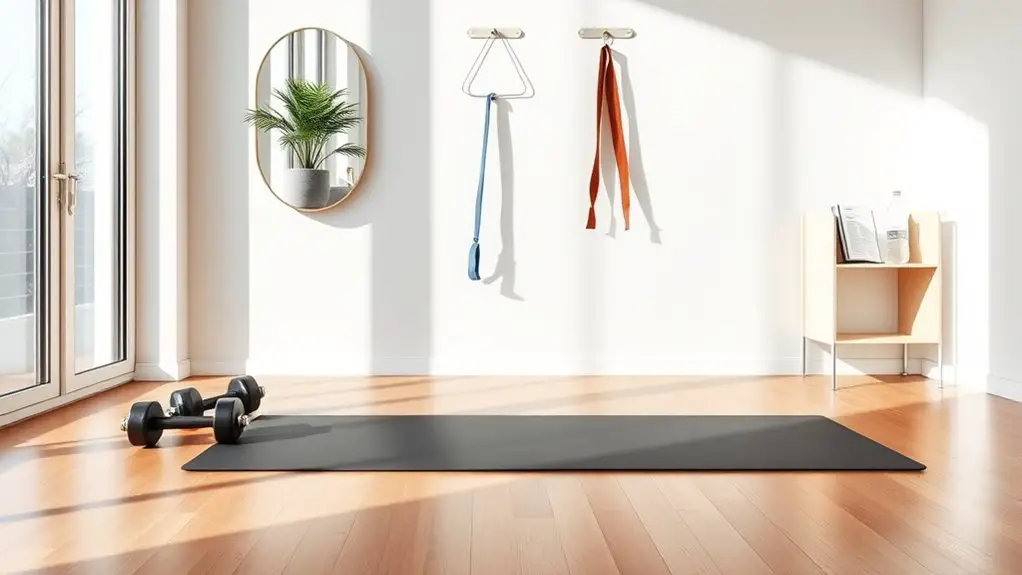
Creating a versatile workout area lays the groundwork for an effective fitness journey, but having the right routine is just as important. A balanced workout routine incorporates strength, flexibility, and cardio, ensuring you stay safe and injury-free. You can achieve this by mixing bodyweight exercises with cardio alternatives. Skipping rope is an excellent cardio workout that elevates heart rate and burns calories efficiently.
Here’s a simple weekly plan to get you started:
| Day | Focus |
|---|---|
| Monday | Bodyweight |
| Wednesday | Cardio |
| Friday | Flexibility |
On bodyweight days, consider push-ups, squats, and planks. For cardio alternatives, incorporate brisk walking, jumping jacks, or cycling. Flexibility days can include yoga or stretching sessions.
Always listen to your body and adjust your routine as needed—safety should be your priority. By incorporating a variety of exercises, you’ll develop strength and endurance while keeping your workouts enjoyable and effective.
Staying Motivated in Your Home Gym
Staying motivated in your home gym is key to reaching your fitness goals. By setting clear objectives, tracking your progress, and sticking to a routine, you can keep your momentum going. Let’s explore how these strategies can help you stay focused and engaged in your workouts.
Set Clear Goals
Setting clear goals is essential for maintaining motivation in your home gym, as it gives you a tangible target to aim for. Effective goal setting can help you stay focused on your fitness journey and achieve those important fitness milestones. Here are some tips to help you establish your goals safely:
- Define specific objectives: Know what you want to achieve, whether it’s losing weight or building strength.
- Set achievable targets: Break down your goals into smaller, manageable steps to avoid overwhelm.
- Include time frames: Assign deadlines to keep yourself accountable and track your progress.
- Prioritize safety: Always choose goals that align with your fitness level and avoid pushing yourself too hard.
With clear goals, you’ll be more motivated and committed to your home gym routine.
Track Your Progress
Tracking your progress is essential, as it not only helps you see how far you’ve come but also keeps you engaged in your fitness journey. One effective method is workout journaling; jot down your exercises, sets, reps, and any improvements. This creates a tangible record of your achievements, making it easier to stay motivated and focused. Regularly reviewing your entries can highlight trends and patterns, allowing you to make necessary adjustments for safety and effectiveness. Progress tracking can also help you identify when you’re ready to increase weights or change routines, ensuring you’re challenging yourself without risking injury. Remember, celebrating small victories in your journey can keep your motivation high and your workouts enjoyable.
Create a Routine
Creating a routine is essential for maintaining motivation in your home gym, especially when the initial excitement starts to fade. A structured fitness schedule can help you stay committed to your home workouts while ensuring you prioritize safety. Here are some tips to create an effective routine:
- Set specific days and times for your workouts to create consistency.
- Include a mix of exercises for strength, cardio, and flexibility to keep things interesting.
- Start with shorter sessions and gradually increase duration as you build endurance.
- Listen to your body; rest when needed and modify exercises to avoid injury.
Tips for Maintaining Your Equipment and Space
While you might be focused on your workout routine, keeping your home gym equipment and space in good shape is equally important. Start with regular equipment cleaning; wipe down surfaces after each use to prevent germs and maintain functionality. Use a mild disinfectant for your weights and mats, guaranteeing a safe environment.
Next, prioritize space organization. Keep your gym tidy by storing equipment in designated areas. Use shelves, hooks, or bins to avoid clutter, which can lead to accidents. Confirm that your workout space is free of obstacles, providing a clear path for your movements.
Finally, check your equipment regularly for wear and tear. Tighten loose screws, inspect cables, and replace any damaged items. By maintaining both your equipment and space, you’ll create a safer, more enjoyable workout environment that keeps you motivated and injury-free. Additionally, using our home gym calculator can help you optimize spending and space usage for your setup.
Frequently Asked Questions
What Are the Best Online Resources for Home Workout Routines?
You’d think finding online resources for home workout routines would be a breeze, but it’s a jungle out there! Luckily, you’ve got some great online platforms to explore. Apps like MyFitnessPal and Nike Training Club offer tailored workouts that keep safety in mind. You can find sessions for all fitness levels, ensuring you won’t risk injury while getting fit. So, plunge into and discover the perfect routine for your journey!
How Can I Incorporate Cardio Into My Home Gym Routine?
Incorporating cardio into your home gym routine can be both fun and effective. You can start with jump rope sessions, which are great for getting your heart rate up while improving coordination. Just make sure you have enough space and a proper surface to avoid injuries. Additionally, try high knees—this exercise boosts your heart rate and strengthens your legs. Remember to warm up and cool down to keep your workouts safe and enjoyable!
What Are Alternative Exercises to Use When I Lack Equipment?
Think of your body as a well-tuned instrument; it doesn’t need fancy equipment to create beautiful music. When you lack gear, bodyweight exercises like push-ups, squats, and lunges can help you stay fit and strong. Resistance bands are fantastic for adding variety and intensity to your routine. Just remember to maintain proper form to avoid injury, and listen to your body—it’s your best coach in this fitness journey.
Can I Effectively Train Multiple Muscle Groups With Minimal Equipment?
Absolutely, you can effectively train multiple muscle groups with minimal equipment. Focus on full body workouts that incorporate bodyweight exercises like push-ups, squats, and lunges. These exercises engage various muscles at once, enhancing strength and endurance safely. You don’t need fancy equipment; just your body and a bit of space. Always listen to your body and maintain proper form to prevent injuries while maximizing your results. Happy training!
How Do I Stay Injury-Free While Working Out at Home?
Staying injury-free while working out at home isn’t just about pushing hard; it’s also about knowing when to ease up. You’ve got to incorporate warm-up techniques that prepare your body, like dynamic stretches or light cardio. Balance that with recovery strategies, such as foam rolling and proper hydration. Rest days aren’t a sign of weakness; they’re essential for healing. Listen to your body, and you’ll build strength safely and effectively.

